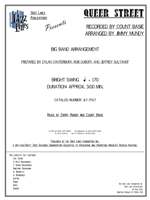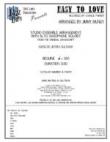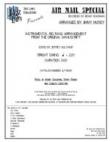QUEER STREET [DOWNLOAD]
Recorded by Count Basie
Arranged by Jimmy Mundy, Prepared by Dylan Canterbury, Rob DuBoff, and Jeffrey Sultanof

Cat #: JLP-7667DL
$65.00This product is available for immediate download after purchase.
Questions?
Please call +1-518-587-1102 or email us.
Edition: Jazz Big Band Arrangement
Description: Swing - Medium Difficult
Publisher: Jazz Lines Publications
Jimmy Mundy's Queer Street marks an interesting "tweener" entry into the Count Basie discography. Recorded in 1945, it finds the Basie band in a moment of transition between the looser head arrangement style of the 1930s and the more orchestrated direction it would move in within the next few years. Add in a pinch of bebop influence for good measure and you have a highly unique but tasty combination of musical ingredients.
With regard to the title, the term “Queer Street” is an early 19th Century term that historically has been used to signify an imaginary street or place where people of lesser means, inferior social class, ill repute, or those in sudden shock now dwell, especially as a result of errors in judgment, sudden financial hardship, or daze due to temporary brain trauma. The term was often used in boxing circles (as early as 1825) to describe an imaginary place or state of mind that a boxer may be dispatched to as a result of being struck in the head by an opposing combatant. Our suspicion is that Mundy had this latter reference in mind when naming this arrangement, especially when taking into account the sudden and surprising harmonic movement at different points during the composition.
A steadily pulsing bass line introduces the arrangement before a slightly off-key trumpet fanfare enters at measure 5. The arrangement features the unusual technique of the trumpets fanning their cup mutes like plungers. Eventually the trombones join in for a slight modification of the earlier bass line. Measure 17 sees an ominously ascending trumpet figure that eventually shepherds the entire band together. The trumpets perform an inverted fanfare to send the chart back to more familiar territory - a simple two choruses of Basie piano blues at measure 29. This is followed by a trumpet solo at measure 42 over a new 32-bar form that features some bebop-influenced chromatic harmony and simple saxophone accompaniment.
The trumpet solo is followed by what is essentially a lengthy send-off beginning at measure 72. The rhythmic motion comes largely from the trombones at first before the saxophones take the spotlight briefly at measure 88, setting up a key change four measures later with yet another new melodic motif. The brass play a simple descending cadence over a similarly descending harmonic structure, with a few quick tenor sax solo interjections to break things up. A classic Basie set-up riff at measure 106 launches the band into the concluding salvo, with a harmonic cadence that shifts downward in minor 3rds, first in increments of measures before speeding up to individual beats in the final two measures.
2 Alto Saxophones
2 Tenor Saxophones
Baritone Saxophone
4 Trumpets
4 Trombones
Guitar
Piano
Bass
Drums
Trombones 1-4: Ab4










